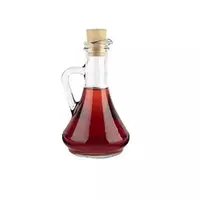Pink vinegar

Vinegar, along with wine, bread, as well as cheese and some other products, belongs to the list of the most ancient and widely used throughout the planet Earth. Vinegar is obtained as a result of the natural process of fermentation of raw materials containing alcohol, which in science is called microbiological synthesis. At its core, vinegar is a product that contains a significant amount of acetic acid.
In the food industry, vinegar is divided into two main types - synthetic and natural. The two main varieties of vinegar differ not only in the method of production and chemical composition, as well as in their taste and consumer characteristics. Synthetic vinegar is obtained by mixing concentrated acetic acid and water.
Such a product has no aromatic or beneficial properties. However, like a natural product, synthetic vinegar has a characteristic aroma. Natural vinegar stands out for its rich bouquet of flavors and flavours. In addition, natural vinegar, if used correctly, can serve as an effective drug.
Over the thousand-year history of the product, a huge number of various vinegar recipes have accumulated. It is worth noting that people love and value vinegar so much that they make the product for pleasure. Vinegar can be a great hobby. Professionals and true connoisseurs of the product create entire vinegar collections.
Homemade vinegar is valued much higher than a natural product produced industrially. To mix and blend vinegar, you need to have a large baggage of knowledge. Among the most popular varieties of home product can be distinguished pink vinegar. Perhaps the rose can be called the most famous flower in the world.
However, pink vinegar is produced from rose hips rather than pink inflorescences. Pink vinegar is made from pre-dried rose hips petals. Various types of plant can be used to make pink vinegar. It is noteworthy that in principle, as such, there is no single recipe for preparing pink vinegar.
As a rule, the following ingredients are most often used in the process of producing pink vinegar: capsicum, nutmeg, cinnamon, as well as cloves. All of the above listed ingredients and dried rose hips are placed on the bottom of a glass acetic bottle. Then the so-called strong preferably natural vinegar is poured into the bottle.
It can be used to make pink vinegar and a synthetic base. However, pink vinegar made not based on natural vinegar will be significantly inferior in quality. The pink vinegar is pressed until completely ready for several weeks, then the pumping is strained and the finished product is poured into a new container.
pink vinegar 11.3 kCal
Energy value of rose vinegar (Ratio of proteins, fats, carbohydrates - ju):
Proteins: 0 g (~ 0 kCal)
Fats: 0 g (~ 0 kCal)
Carbohydrates: 3g (~ 12kCal)
Energy ratio (bj | y): 0% | 0% | 106%
 Español
Español Français
Français Português
Português Русский
Русский 简体中文
简体中文 繁體中文
繁體中文 日本語
日本語 한국어
한국어 العربية
العربية Türkçe
Türkçe Қазақ
Қазақ Deutsch
Deutsch Italiano
Italiano Українська
Українська
